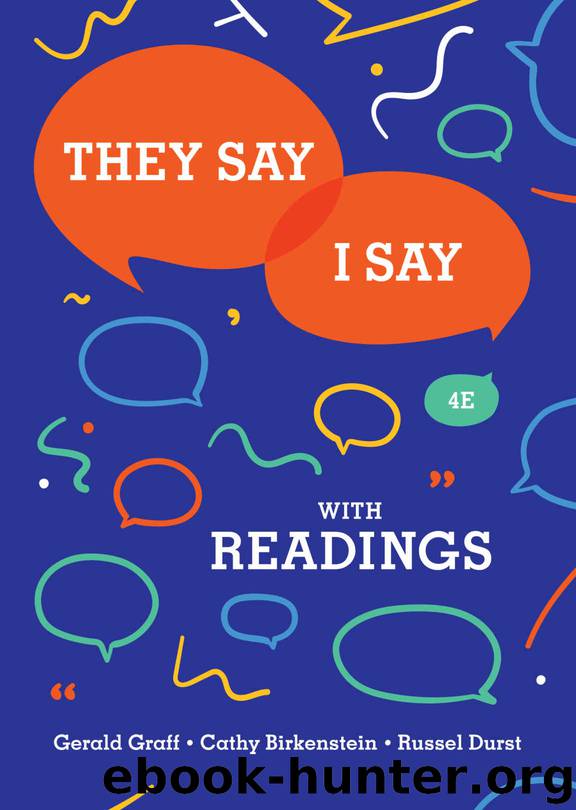They Say I Say: The Moves That Matter in Academic Writing with Readings (Fourth Edition) by Cathy Birkenstein & Russel Durst & Gerald Graff

Author:Cathy Birkenstein & Russel Durst & Gerald Graff [Birkenstein, Cathy]
Language: rus
Format: epub
Publisher: W. W. Norton & Company
Published: 2018-05-31T21:00:00+00:00
Shut Up about Harvard
b e n c a s s e l m a n
H
A focus on elite schools ignores the issues most college students face.
It’s college admissions season, which means it’s time
once again for the annual flood of stories that badly misrep-
resent what higher education looks like for most American
students—and skew the public debate over everything from
student debt to the purpose of college in the process.
“How college admissions has turned into something akin
to ‘The Hunger Games,’ ” screamed a Washington Post head-
line Monday. “What you need to remember about fate dur-
ing college admission season,” wrote Elite Daily earlier this
month. “Use rejection to prepare teens for college,” advised
The Huffington Post.
Ben Casselman is an economics writer and senior editor for FiveThirty-
Eight, a website that “uses statistical analysis—hard numbers—to tell
compelling stories about elections, politics, sports, science, economics,
and culture.” Previously, Casselman worked for Salem News and the
Wall Street Journal, where he was nominated for a Pulitzer Prize for a
story about the Deepwater Horizon oil spill. This essay first appeared on
FiveThirtyEight on March 30, 2016.
3 9 0
Shut Up about Harvard
Here’s how the national media usually depicts the admis-
sions process: High school seniors spend months visiting col-
leges; writing essays; wrangling letters of recommendation; and
practicing, taking and retaking an alphabet soup of ACTs,
SATs and AP exams. Then the really hard part: months of
nervously waiting to find out if they are among the lucky few
(fewer every year, we’re told!) with the right blend of academic
achievement, extracurricular involvement and an odds-defying
personal story to gain admission to their favored university.
Here’s the reality: Most students never have to write a
college entrance essay, pad a résumé or sweet-talk a poten-
tial letter-writer. Nor are most, as the Atlantic put it Monday,
“obsessively checking their mailboxes” awaiting acceptance
decisions. (Never mind that for most schools, those decisions
now arrive online.) According to data from the Department of
Education,1 more than three-quarters of U.S. undergraduates2
attend colleges that accept at least half their applicants; just 4
percent attend schools that accept 25 percent or less, and hardly
any—well under 1 percent—attend schools like Harvard and
Yale that accept less than 10 percent.
Media misconceptions don’t end with admission. “College,” 5
in the mainstream media, seems to mean people in their late
teens and early 20s living in dorms, going to parties, study-
ing English (or maybe pre-med) and emerging four years later
with a degree and an unpaid internship. But that image, never
truly representative, is increasingly disconnected from reality.
Nearly half of all college students attend community colleges3;
among those at four-year schools, nearly a quarter attend part
time and about the same share are 25 or older. In total, less
than a third of U.S. undergraduates are “traditional” students
in the sense that they are full-time, degree-seeking students at
primarily residential four-year colleges.4
3 9 1
Download
This site does not store any files on its server. We only index and link to content provided by other sites. Please contact the content providers to delete copyright contents if any and email us, we'll remove relevant links or contents immediately.
Asking the Right Questions: A Guide to Critical Thinking by M. Neil Browne & Stuart M. Keeley(5644)
Autoboyography by Christina Lauren(5184)
Eat That Frog! by Brian Tracy(4436)
Dialogue by Robert McKee(4323)
Sticky Fingers by Joe Hagan(4103)
Journeys Out of the Body by Robert Monroe(3572)
Annapurna by Maurice Herzog(3424)
Full Circle by Michael Palin(3389)
Schaum's Quick Guide to Writing Great Short Stories by Margaret Lucke(3319)
Elements of Style 2017 by Richard De A'Morelli(3307)
The Art of Dramatic Writing: Its Basis in the Creative Interpretation of Human Motives by Egri Lajos(3016)
Atlas Obscura by Joshua Foer(2899)
The Diviners by Libba Bray(2887)
In Patagonia by Bruce Chatwin(2876)
Why I Write by George Orwell(2875)
The Fight by Norman Mailer(2848)
The Mental Game of Writing: How to Overcome Obstacles, Stay Creative and Productive, and Free Your Mind for Success by James Scott Bell(2845)
Venice by Jan Morris(2526)
The Elements of Style by William Strunk and E. B. White(2442)
